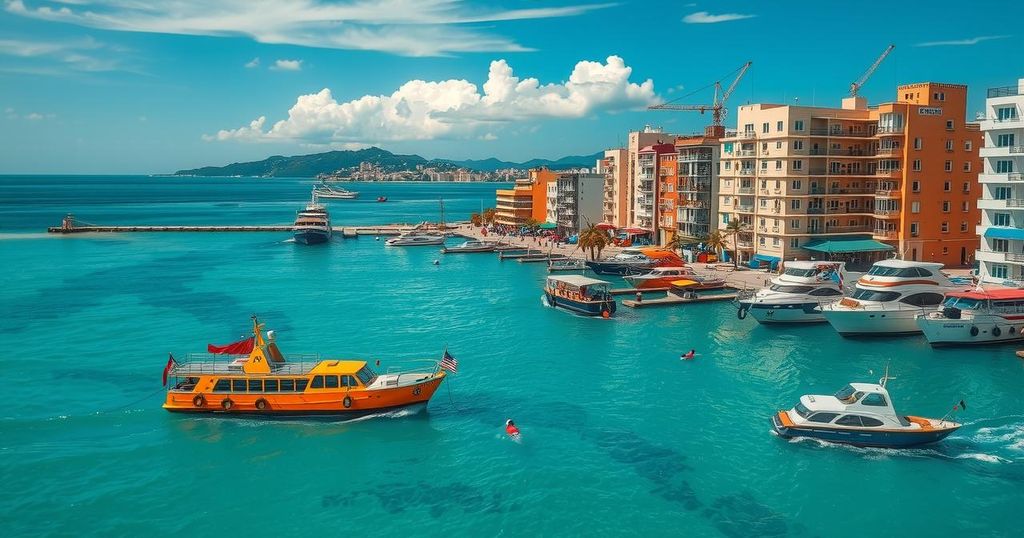Cuba’s tourism is experiencing a sharp decline, down 73.93% in North American visitors since 2019. Overall tourist arrivals decreased by 48.23% from January to October 2024 compared to 2019. Economic challenges, poor infrastructure, and competition from other Caribbean destinations contribute to this downturn. While there are slight increases in visitors from Portugal and Russia, Cuba’s tourism sector faces significant struggles, exacerbated by management issues and changing travel patterns among the Cuban diaspora.
Cuba’s tourism industry is currently experiencing a significant downturn, marked by a notable decline in international arrivals, particularly from North America, Spain, Germany, Mexico, Argentina, and Colombia. Visitor numbers plummeted dramatically, with North American tourists falling from 452,835 in 2019 to a mere 118,038 in 2024, representing a staggering 73.93% decrease. Although some increases have been recorded in visitors from Portugal and Russia, this has not offset the widespread decline seen across other key markets. The collapse of tourist numbers can be attributed to Cuba’s ongoing economic difficulties, inadequate infrastructure, and stiff competition from neighboring Caribbean destinations such as Cancun and Punta Cana, which are proving more attractive to international travelers.
Between January and October 2024, Cuba documented an alarming 48.23% reduction in tourist arrivals compared to pre-pandemic figures in 2019. The hotel’s occupancy rate has drastically fallen to 25%, a sharp contrast to its bustling atmosphere during the pre-pandemic era. The once-thriving tourism revenue, which peaked at USD 3,185 million in 2019, has plunged to just USD 1,216 million by 2023, marking a decrease of 61.82%.
A noteworthy aspect of the decline is the reduced travel frequency of the Cuban diaspora, which historically constituted a substantial segment of the tourist population. Despite over 800,000 Cubans immigrating to the U.S. in the past three years, many of them are opting for tropical retreats in the Dominican Republic or Mexico instead of traveling back to Cuba, affecting domestic tourism significantly.
The Grupo de Administración Empresarial S.A. (GAESA), which governs much of Cuba’s financial activities, has been criticized for its mismanagement of resources. Over the last 15 years, GAESA has invested USD 24 billion in tourism infrastructure, while neglecting vital sectors such as electricity generation, healthcare, and agriculture. As a result, the country’s tourism goals remain unmet, including the latest target of attracting 3.5 million visitors in 2024, which now seems unlikely to be achieved.
Cuba’s energy sector is unstable, leading to common power outages that affect daily life and deter tourists. Additionally, health concerns due to epidemics, a failing healthcare system, increased crime rates, and food shortages are major deterrents for potential visitors. The withdrawal of key airlines and tour operators has further restricted accessibility, exacerbating the tourism slump.
As travelers turn to destinations with better amenities and safety, such as Cancun and Punta Cana, Cuba has seen its previously significant tourism base erode. While the government has encouraged Cuban migration in hopes of increasing remittances and attracting the exiled community back to the island, the strategy has largely failed, with many expatriates preferring alternatives to their homeland.
For recovery, Cuba must address systemic issues by investing in essential infrastructure and diversifying its economy. Enhancing international relations to attract airlines and tour operators is vital to revitalize the industry. Despite its significant challenges, Cuba possesses the potential for recovery by emphasizing sustainable development and infrastructure improvement to regain the trust of international travelers. The island must confront the complexities of its situation to revive tourism, which has historically been its economic lifeline.
Cuba has long been recognized as a Caribbean travel destination; however, recent economic and infrastructural challenges have severely affected its tourism industry. The pandemic dealt a heavy blow to global travel, but Cuba has struggled to recapture its pre-pandemic visitor levels. Currently, the island’s tourism sector is grappling with significant declines in arrivals from key markets, amidst growing competition from other Caribbean locations that offer better facilities and experiences for travelers. These challenges include infrastructure issues, economic mismanagement, and changes in diaspora travel patterns, all of which have contributed to the current crisis.
The decline in Cuba’s tourism reflects a complex interplay of economic, infrastructural, and competitive factors that have strained its tourism-dependent economy. While dips in visitor numbers from primary markets such as North America and Europe are alarming, there are slight positive trends with increased visitors from Portugal and Russia. Cuba must address its systemic challenges through investment in essential services and infrastructure improvements to revive its tourism sector, thus reclaiming its position as a leading Caribbean destination.
Original Source: www.travelandtourworld.com






